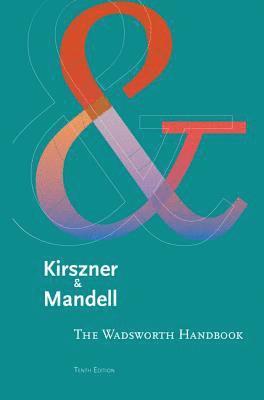
- Format
- Pamphlet
- Språk
- Engelska
- Antal sidor
- 864
- Utgivningsdatum
- 2013-01-01
- Upplaga
- 10
- Förlag
- Wadsworth Publishing
- Medarbetare
- Mandell, Stephen
- Illustrationer
- illustrations
- Dimensioner
- 218 x 147 x 36 mm
- Vikt
- Antal komponenter
- 1
- ISBN
- 9781133308775
- 885 g
The Wadsworth Handbook
Slutsåld
Kundrecensioner
Fler böcker av Laurie Kirszner
-
PORTABLE Literature
Laurie Kirszner, Stephen Mandell, Laurie Kirszner, Stephen Mandell
Kirszner/Mandell's PORTABLE LITERATURE: READING, REACTING, WRITING, 10th Edition is a highly accessible anthology that offers a broad selection of contemporary and classic, time-tested readings along with introductions to the literary genres, help...
Recensioner i media
"I really have not used a better book of this type in my total career."
Övrig information
Laurie G. Kirszner is a nationally known, best-selling author. Kirszner and coauthor Stephen R. Mandell have written best sellers for nearly every English market. They have the deepest publishing record of any literature anthology author team and have successfully published up and down the curriculum from developmental to literature. Stephen R. Mandell is a nationally known, best-selling author. Mandell and coauthor Laurie G. Kirszner have written best sellers for nearly every English market. They have the deepest publishing record of any literature anthology author team and have successfully published up and down the curriculum from developmental to literature.
Innehållsförteckning
Note to Students.
Note to Instructors.
PART 1: WRITING ESSAYS.
1. Understanding Purpose, Audience, and Tone.
2. Reading Texts.
3. Reading Visuals.
4. Planning an Essay.
5. Using a Thesis to Shape Your Essay.
6. Drafting and Revising.
7. Writing Paragraphs.
PART 2: THINKING CRITICALLY AND WRITING ARGUMENTS.
8. Thinking Critically.
9. Using Logic.
10. Writing Argumentative Essays.
11. Using Visuals as Evidence.
PART 3: DOING RESEARCH.
12. Writing a Research Paper.
13. Finding Information.
14. Evaluating Sources.
15. Summarizing, Paraphrasing, and Quoting Sources.
16. Synthesizing Sources.
17. Avoiding Plagiarism .
PART 4: DOCUMENTING SOURCES: MLA STYLE.
18. MLA Documentation Style.
PART 5: DOCUMENTING SOURCES: APA AND OTHER STYLES.
19. APA Documentation Style.
20. Chicago Documentation Style.
21. CSE and Other Documentation Styles.
PART 6: WRITING IN THE DISCIPLINES.
22. Writing in the Humanities.
23. Writing a Literary Analysis.
24. Writing a Literary Argument.
25. Writing in the Social Sciences.
26. Writing in the Natural and Applied Sciences.
PART 7: CREATING DOCUMENTS IN A DIGITAL AGE.
27. Writing in a Digital Environment.
28. Designing Effective Documents.
29. Designing a Web Site.
PART 8: DEVELOPING STRATEGIES FOR ACADEMIC AND PROFESSIONAL SUCCESS.
30. Creating a Writing Portfolio.
31. Writing Essay Exams.
32. Writing for the Public and the Community.
33. Writing for the Workplace.
34. Making Oral Presentations.
PART 9: SENTENCE STYLE.
35. Building Simple Sentences.
36. Building Compound and Complex Sentences.
37. Writing Varied Sentences.
38. Writing Emphatic Sentences.
39. Writing Concise Sentences.
PART 10: SOLVING COMMON SENTENCE PROBLEMS.
40. Revising Fragments.
41. Revising Run-ons.
42. Revising Misplaced and Dangling Modifiers.
43. Revising Faulty Parallelism.
44. Revising Awkward or Confusing Sentences.
PART 11: USING WORDS EFFECTIVELY.
45. Choosing Words.
46. Improving Spelling.
PART 12: UNDERSTANDING GRAMMAR.
47. Using Parts of Speech.
48. Using Nouns and Pronouns.
49. Using Verbs.
50. Revising Agreement Errors.
51. Using Adjectives and Adverbs.
PART 13: UNDERSTANDING PUNCTUATION AND MECHANICS.
Overview of Sentence Punctuation: Commas, Semicolons, Colons, Dashes, Parentheses (Chart).
52. Using End Punctuation.
53. Using Commas.
54. Using Semicolons.
55. Using Apostrophes.
56. Using Quotation Marks.
57. Using Other Punctuation Marks.
58. Knowing When to Capitalize.
59. Using Italics.
60. Using Hyphens.
61. Using Abbreviations.
62. Using Numbers.
PART 14: BILINGUAL AND ESL WRITERS.
63. Adjusting to the US Classroom.
64. Grammar and Style for ESL Writers.
Glossary of Usage.
Glossary of Grammatical and Rhetorical Terms.
Credits.
Index.
Du kanske gillar
-
Let Them Theory
Mel Robbins
Inbunden -
Atomic Habits
James Clear
Trade paperback (UK) -
Man and His Symbols
C G Jung
Häftad -
The Creative Act
Rick Rubin
Inbunden
